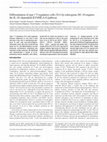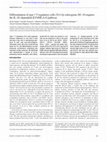Papers by Valentina Pacciani

Blood, May 1, 2010
and play a key role in maintaining tolerance to self-and non-self-antigens. Interleukin-10 (IL-10... more and play a key role in maintaining tolerance to self-and non-self-antigens. Interleukin-10 (IL-10) is the crucial driving factor for Tr1 cell differentiation, but the molecular mechanisms underlying this induction remain unknown. We identified and characterized a subset of IL-10producing human dendritic cells (DCs), termed DC-10, which are present in vivo and can be induced in vitro in the presence of IL-10. DC-10 are CD14 ؉ , CD16 ؉ , CD11c ؉ , CD11b ؉ , HLA-DR ؉ , CD83 ؉ , CD1a ؊ , CD1c ؊ , express the Ig-like transcripts (ILTs) ILT2, ILT3, ILT4, and HLA-G antigen, display high levels of CD40 and CD86, and up-regulate CD80 after differentiation in vitro. DC-10 isolated from peripheral blood or generated in vitro are potent inducers of antigen-specific IL-10producing Tr1 cells. Induction of Tr1 cells by DC-10 is IL-10-dependent and requires the ILT4/HLA-G signaling pathway. Our data indicate that DC-10 represents a novel subset of tolerogenic DCs, which secrete high levels of IL-10, express ILT4 and HLA-G, and have the specific function to induce Tr1 cells. (Blood. 2010;116(6): 935-944)
World Journal of Pediatrics, 2011
Methods: Ten children with allergic asthma sensitive to house dust mite were studied before and a... more Methods: Ten children with allergic asthma sensitive to house dust mite were studied before and after 12 months of SLIT. Immature DCs were derived from peripheral blood monocytes cultured for 6 days in presence of interleukin (IL)-4 and GM-CSF and stimulated with lipopolysaccharide for the last 24 hours to induce maturation.
Journal of Allergy and Clinical Immunology, 2010

European Journal of Immunology, 2005
Cellular immune responses are induced during hepatitis C virus (HCV) infection and acute-phase CD... more Cellular immune responses are induced during hepatitis C virus (HCV) infection and acute-phase CD8+ T cells are supposed to play an important role in controlling viral replication. In chimpanzees, failure of CD8+ T cells to control HCV replication has been associated with acquisition of mutations in MHC class I-restricted epitopes. In humans, although selection of escape mutations in an immunodominant CTL epitope has been recently described, the overall impact of immune escape during acute HCV infection is unclear. Here, by performing an in depth analysis of the relationship between early cellular immune responses and viral evolution in a chronically evolving HCV acutely infected individual, we demonstrate: (i) the presence of a potent and focused CD8(+ T cell response against a novel epitope in the NS3 protein, (ii) the elimination of the quasi-species harboring the original amino acid sequence within this epitope, and (iii) the selection for a virus population bearing amino acid changes at a single residue within the cytotoxic T cell epitope that strongly diminished T cell recognition. These results support the view that acute-phase CD8+ T cell responses exert a biologically relevant pressure on HCV replication and that viruses escaping this host response could have a significant survival advantage.

Blood, 2010
and play a key role in maintaining tolerance to self-and non-self-antigens. Interleukin-10 (IL-10... more and play a key role in maintaining tolerance to self-and non-self-antigens. Interleukin-10 (IL-10) is the crucial driving factor for Tr1 cell differentiation, but the molecular mechanisms underlying this induction remain unknown. We identified and characterized a subset of IL-10producing human dendritic cells (DCs), termed DC-10, which are present in vivo and can be induced in vitro in the presence of IL-10. DC-10 are CD14 ؉ , CD16 ؉ , CD11c ؉ , CD11b ؉ , HLA-DR ؉ , CD83 ؉ , CD1a ؊ , CD1c ؊ , express the Ig-like transcripts (ILTs) ILT2, ILT3, ILT4, and HLA-G antigen, display high levels of CD40 and CD86, and up-regulate CD80 after differentiation in vitro. DC-10 isolated from peripheral blood or generated in vitro are potent inducers of antigen-specific IL-10producing Tr1 cells. Induction of Tr1 cells by DC-10 is IL-10-dependent and requires the ILT4/HLA-G signaling pathway. Our data indicate that DC-10 represents a novel subset of tolerogenic DCs, which secrete high levels of IL-10, express ILT4 and HLA-G, and have the specific function to induce Tr1 cells. (Blood. 2010;116(6): 935-944)

Annals of Allergy, Asthma & Immunology, 2012
An understanding of the mechanisms responsible for the development and maintenance of allergic in... more An understanding of the mechanisms responsible for the development and maintenance of allergic inflammation and their clinical implications is needed to develop specific and successful treatment for allergy. To characterize in vitro T-cell responses to Der p 2, one of the major allergens of house dust mite (HDM), and investigate potential correlations between clinical and laboratory parameters. Forty-two patients monosensitized to HDM and 10 age-matched, healthy children were studied. Dendritic cells pulsed with Der p 2 were used to stimulate autologous CD14(-) cells. Der p 2-specific T-cell activation markers, proliferation, and cytokine production profiles were examined. Der p 2-specific T-cell activation markers, proliferation, and T(H)2 cytokine production were significantly higher in HDM patients compared with healthy controls. Moreover, a significant correlation between proliferation and T(H)2 cytokine production was observed. Within the allergic group, skin reaction to HDM was significantly stronger in patients with a Der p 2-specific T-cell response. Levels of HDM-specific IgE directly correlated with interleukin 5 and interleukin 13 levels and with skin prick test results and, ultimately, with the patient's family history of allergy. Furthermore, the presence of atopic march correlated with T-cell proliferation. We found that, in HDM patients, Der p 2-specific T(H)2 responses, promoted by autologous dendritic cells in vitro, correlate with clinical parameters.

Uploads
Papers by Valentina Pacciani